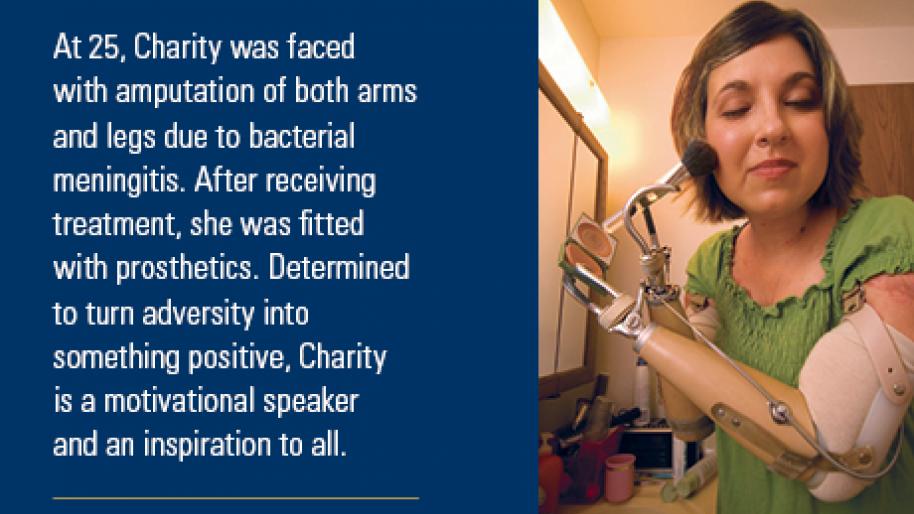About Upper Extremity Amputations
There are many levels of upper extremity amputations, and with each one comes a different method of rehabilitation as well as a different type of prosthesis. At the Upper Extremity Clinic at the University of Michigan, we offer complete, compassionate care, taking you from the amputation process to getting you back to daily living by listening to your needs, providing you a thorough education and utilizing the most current therapy and prostheses available.
In addition to amputation, our Upper Extremity Clinic cares for and treats patients with conditions such as brachial plexus (nerves that control shoulder, arm and hand movement) injuries. We coordinate care among our physiatrists (a physician who specializes in physical medicine and rehabilitation), prosthetists (certified to design, fabricate and fit prostheses) and therapists in order to fully address mobility, pain and function issues.
Levels of Upper Extremity Amputations
Levels of upper extremity amputations include:
- Fingers or partial hand (transcarpal)
- At the wrist (wrist disarticulation)
- Below the elbow (transradial)
- At the elbow (elbow disarticulation)
- Above the elbow (transhumeral)
- At the shoulder (shoulder disarticulation)
- Above the shoulder (forequarter)
Prostheses
Preparing for an Upper Extremity Prothsesis
Before you can get fitted for a prosthesis (a replacement for a lost limb or a limb deficiency), you must first go through physical therapy to gain strength and range of motion, and occupational therapy to learn how to adapt to daily living tasks without a prosthesis. This also gives your wound time to heal, and for the swelling to go down so your prosthesis fits properly. An at home exercise program will be created to prevent contracture (a permanent shortening of a joint due to inactivity).
Most patients are fitted for customized, upper extremity prostheses within 30 days. We do this quickly so you don’t develop a preference for one-handedness. It takes time and patience to learn how to perform daily tasks with a prosthesis, so a quicker transition will make you more likely to use your prosthesis.
Your First Prosthesis
Your first prosthesis is called a provisional prosthesis. Your limb will still be healing and changing at this point and you won’t get your definitive (final) prosthesis until the limb is stabilized. Think of it as getting used to a one-speed bike before taking off on a 27-speed mountain bike. You may need therapy to learn how to use your prosthesis. There are a variety of prosthesis options, which your team will discuss with you, based on your age, lifestyle, needs and insurance.
Orthotics & Prosthetics Center
Our Orthotics & Prosthetics Center has been awarded a three-year accreditation by the American Board for Certification in Orthotics, Prosthetics & Pedorthics, Inc., and is among the few university-based facilities in the country that offer comprehensive orthotic and prosthetic services. We custom design orthotics and prosthetics to fit each patient’s individual needs, and utilize CAD/CAM (computer-aided design/computer-aided manufacturing) to quickly and efficiently design and fabricate the devices, using 3-D imaging.
Our outpatient center is conveniently located in Ann Arbor, minutes from I-94 and US-23. Free parking and easy access to the facility is available. Call ahead and we can provide wheelchair support. We require prescriptions for most of our orthotics and prosthetics services. Some walk-in services are available. Please call ahead.
Make an Appointment
To make an appointment with our amputee clinic or post-polio physician specialists, please call the Orthotics & Prosthetics Call Center at (734) 973-2400. For other contact and appointment information related to Rehabilitation Medicine, visit our Make an Appointment with Rehabilitation Medicine page.


